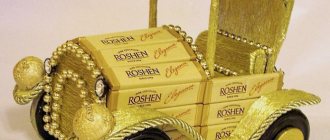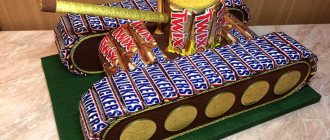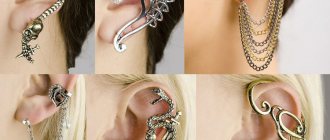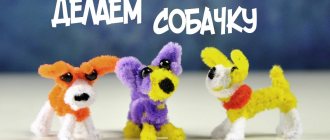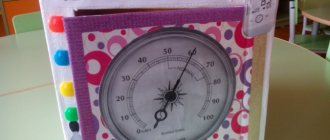DIY mini-figure of a motorcycle made from nuts
Miniature versions of technology are great ideas for crafts, to occupy your own free time, and also as a souvenir for those who are interested in technology. The figurines are especially interesting because they are assembled from scrap metal parts.
Materials
To make a motorcycle figurine with your own hands, prepare:
- various nuts;
- metal springs;
- bolts;
- metal rods;
- pieces of wood;
- oil or wax for polishing wooden products;
- soldering iron and solder;
- tool for cutting metal rods;
- woodworking tools;
- sandpaper;
- pliers.
Step 1
. Assemble the front of the motorcycle. Use a nut as a wheel. Solder two screws to it. And to them, slightly bending them in advance, attach two more elongated metal, pre-bent, thin rods. As the latter, you can take any suitable parts or thick pieces of wire.
Step 2
. Take a metal rod and cut it into two equal parts. You can determine the parameters yourself, based on the planned dimensions of the figure. Use pliers to bend the pieces of the rod. A small bend will be needed to secure the rear wheel of the motorcycle. The straight section of the rod in this case was approximately 6 cm, after this section it will again need to be bent upward, forming the part that will be attached to the steering wheel.
The rod will need to be welded to the rear wheel nut and the two parts in front of them welded to the existing workpiece.
Step 3
. Now you will need to add any details you have to the figurine, creating a harmonious composition. In this case the following were used:
- two large springs welded together as a motorcycle engine;
- two flat-end mounts as pedals;
- lots of nuts.
Step 4
. Cut the tank and seat from small pieces of wood. First, give the parts rough outlines, then process them to a more refined shape and sand the surface to perfect smoothness.
Step 5
. Treat wooden pieces with furniture wax and polish the parts. If you wish, you can, of course, replace them with metal products of a similar shape, but the combination of metal and natural wood looks more impressive.
Step 6
. Attach the wooden pieces to the motorcycle figurine.
Ready!
3.9 / 5 ( 37 votes)
Similar articles:
- DIY soap – Blue windows
- DIY papier-mâché maracas
- DIY funny children's backpack "Minion"
- DIY drawing on a T-shirt
Model of a motorcycle from scrap materials (17 photos)
zubrilov
Last time I posted photos of my crafts from old radio components. A friend saw them and gave me the idea to build a motorcycle, I liked the idea. After racking my brains a little, I began to select parts and began assembly.
I sketched out a simple drawing of the frame on paper and selected resistors of suitable sizes:
After assembling the frame, I moved on to the wheels, I took the disks and pancake fasteners from hard disks as a basis, selected the beads in size and a couple of gears:
Having assembled the model a little, I also realized that the frame and the motorcycle itself were somehow flimsy and unreliable and did not look as good as I would like, so I decided to change the concept a little and took copper wire as a basis. Wire frame:
added a spring-loaded seat to the frame:
This design turned out to be much stronger, and in my opinion it looks much better.
Then I took thin copper plates and made the rear wing:
and behind it, from the same plate, by cutting and soldering, I made a fuel tank:
I made a fork for the front wheel from a wire, bent a steering wheel from a thinner wire, and wound springs from an even thinner wire. I collected everything in a pile and hung the parts in their places:
Then it was time for the engine, I puzzled over it for a long time, then I found a wire (tin solder) of a suitable size and began to knock out and grind out the cylinders:
I added some kind of gearbox to the engine, made fins on the cylinders and added wires that in the original go to the spark plugs:
I made an exhaust system from wire and tubes:
Covered the seat with leatherette. I made a simple case out of it:
And then I put everything together, made a headlight from a plastic cylinder and transparent plastic, finished the steering wheel, adding rear-view mirrors and handles. And painting, so as not to rack my brains for a long time, I took nail polish, it goes on quite well, there are interesting colors and dries quickly.
A few photos of the finished bike:
This is my first such experience and I really enjoyed the creation process. This motorcycle is already going away as a gift. By the way, a very good gift option for bikers and just motorcycle enthusiasts)
Source: sdelay-sam.su
Tags: motorcycle model, homemade motorcycle
Did you like the post? Support Chips, click:
Partner news
fishki.net
Wire motorcycle
Very often we see the world's largest manufacturers posting screenshots of their models in various graphic editors. When I came across the picture below, I thought that this was someone else’s work in 3DS Max.
As it turned out later, this was not a graphic editor at all, but three years of work by the Chinese artist Shi Jindian, who made a model of the Chiang Jiang 750 motorcycle from wire.
Chinese idiosyncratic sculptor Shi Jindian makes motorcycle models using a hook and steel wire. Of course, a full-size layout is used for creation, which is deleted after completion. The photo shows a model of the Chang Jiang 750 motorcycle, the original of which the Chinese tore off from the Russian IMZ M-72 motorcycle, and we, in turn, from the 1937 BMW R71.
How to make a motorcycle from bearings and bolts? /DIY Miniature Motorcycle?
DIY motorcycle made from bolts and nuts. Read more
With my own hands. Bike souvenir.More
Motorcycle made of nuts and bolts. Souvenir.More details
DIY motorcycle souvenir. Business idea made of nuts and bolts. Read more
Motorcycle model made from nuts and boltsRead more
Crafts for kindergarten. Motorcycle made of nuts and bolts.Read more
A motorcycle made from scrap metal in 3 minutes. Hobby in "Garage4x4".More
Incredible! I made an exact model of a MOTORCYCLE from cardboardRead more
Combat motorcycle toy with own handsRead more
motorcycle made of bolts and nuts 2Read more
Craft from junk motorcycle part 1Read more
Wooden motorcycle (Magic table). Series No. 1.Magic table. Episode 1 – Wooden motorcycle. Puzzles.More details
from bolts and nuts motorcycle.Read more
A MASTERPIECE made from bolts and nuts with your own hands. Cool keychain!More details
MOPED-STREET FIGHTER FROM CHAINSAW AND BIKREAD MORE
HOW TO MAKE A MOTORCYCLE FROM WOOD WITH YOUR OWN HANDS / how to make a bikeRead more
Motorcycle made from Bolts and Nuts.Read more
How to make a motorcycle from DIY plasticineRead more
Source
HOW I MAKE MOTORCYCLES
A year or two passes - and the tool boxes begin to rattle, cracks creep along the rear fender, the number plate along with the bracket falls off... And if the motorcyclist, God forbid, gets into even a minor accident or even simply falls? In these cases, the frame bends and dents appear on the tank and tool boxes. Huge lower mufflers cause even more trouble, clinging even to smooth asphalt when cornering and significantly reducing passability on bad roads.
The two-wheeled vehicle, designed according to the “monocoque” design scheme, is free of all these shortcomings. Such a motorcycle is a monoblock welded box-shaped structure that performs the functions of all the parts and assemblies listed above. Interestingly, the spatial box structure is significantly more rigid and durable than the classic frame structure (including duplex frames). The use of a monocoque design in a motorcycle design not only reduces the weight of a two-wheeled vehicle, but also brings the center of gravity of the motorcycle closer to the ground. This happens due to the fact that in this design the tool box and battery compartment are located in the lower part of the body, and a lightweight air filter with an intake noise muffler is located in the upper part, where the fuel tank cap is located on classic motorcycles. The air intake is made above the steering column - in this area the cleanest, dust-free air is. An exhaust noise muffler may also be located inside the monocoque, but reliable thermal insulation from the fuel and seat cushion must be ensured.
Rice. 1. Enduro-type motorcycle with a monocoque body designed by L. Garagashyan:
1 — rearview mirror, 2 — secret fuel tank plug, 3 — shock absorber compensation chamber, 4 — shock absorber with a stroke of 120 mm, 5 — swing arm, 6 — push lever, 7 — brake rod, 8 — rear part of the body with exhaust muffler (left) and oil tank (right), 9 — rear turn signal, 10 — parking light and brake light (dual), 11 — exhaust pipe (left), 12 — brake disc with a diameter of 300 mm, 13 — chain catcher, 14 — rear wheel sprocket (z=37), 15 — rear wheel suspension pendulum, 16 — drive sprocket (z=15), 17 — foot brake pedal, 18 — drive box lever gears, 19 - winch drum, 20 - muffler - resonator, 21 - winch cable guide bracket, 22 - front brake disc with a diameter of 300 mm.
Rice. 2. Monocoque body layout. The cell size of the scale grid is 100×100 mm.
Rice. 3. Diagram of the most rational welds used in assembling a monocoque body.
Pictures 1 and 2 show my enduro motorcycle and its monocoque body with rear suspension and engine protective frame. The weight of the monocoque is only 23 kilograms, and the useful volume of such a body is about 56 liters, of which 41 liters are for fuel tanks (more than that of the Zhiguli!), and the remaining volume of the body is fully used. At the same time, the motorcycle does not look bulky. On the contrary, it has relatively small dimensions - in particular, the base of the car is only 1350 mm (smaller than any Izhevsk motorcycle).
It must be said that making a monocoque body is no more difficult than welding a good frame and equipping it with all the attached parts. You just need to strictly adhere to the pre-developed technology so that all the parts fit together well and are convenient to weld.
When drawing the design of the body, take care to ensure a comfortable position for the driver - this is especially important for enduro-type motorcycles - as well as the safety of the motorcyclist’s movements, ease of movement in a sitting position, in a rack and in the drawbar.
After choosing the optimal, in the designer’s opinion, layout solution, you should draw the entire motorcycle in full size - depict a side view, top view, front and rear, and also draw the most characteristic sections. The more detailed the drawing documentation, the easier further work on the manufacture of a two-wheeled vehicle will be.
It is most rational to place the engine directly on the axis of the pendulum. In this case, the reaction from the tension of the drive chain is connected directly to the pendulum. And it is far from small - sometimes it reaches the breaking strength of the chain, that is, almost two tons! It is necessary to mount the powerful and not very well balanced Izh-Planet engine (as well as all cross-country motors) using silent blocks or rubber cushions. You just need to take into account that the chain not only pulls the engine back, but also turns it in a horizontal plane due to the asymmetrical arrangement of the chain.
When creating a monocoque body, it is very convenient to use the volumetric prototyping method. In this case, the model of the body is assembled from cardboard blanks, which are connected using strips of paper and glue. In the process of making a model, as a rule, changes occur in the design of the body, since not everything can be provided for in flat drawing projections. Simultaneously with prototyping the body, it is advisable to work out a technological map of its assembly - this will ensure the convenience of welding work. It is necessary to take into account the possible warping of metal workpieces when welding the body with uneven heating. Keep in mind that the parts that hold the swingarm and steering column are welded last. If necessary, they should be adjusted to the body so that on the finished motorcycle the planes of the wheels coincide with the plane of symmetry of the monocoque body.
The finished volumetric model is cut at the gluing points, and the cardboard patterns of the monocoque elements are numbered: it is from these patterns that blanks will be cut from a steel sheet of the appropriate thickness - from 1.2 to 1.5 mm. The easiest way to do this is with a chisel on a massive anvil.
Welding should be carried out in strict accordance with the technological map. To make the seams look neat and strong, the edges of the parts being welded should be slightly bent, as shown in Figure 3.
To ensure sufficient strength of the monocoque body, it is advisable to introduce additional reinforcements, flanges, and stiffeners into its design. For example, the steering column on my motorcycle and the transverse stiffening beam, to which the bracket for the only shock absorber of the rear suspension is welded, are additionally connected by a rectangular steel pipe of 25x40 mm. In addition, it is convenient to place electrical wiring and motorcycle control cables inside this pipe.
The design of the intake silencer significantly affects the engine power and its torque characteristics. The larger its volume, the easier the engine “breathes,” and the less air pulsation in the filter, which means less noise. Experts recommend setting the muffler volume to at least 20 engine displacements. The path from the air filter to the carburetor must be smooth, eliminating turbulence in the air flow, which significantly reduces engine power.
After welding, the monocoque body is checked for leaks - first with water and then with clean gasoline. If there are no leaks, the welds are coated from the inside with liquid epoxy glue - it will fill small pores, bind pieces of slag and drops of metal - this is especially important for the intake noise muffler.
The rear suspension is pendulum type, with cantilever wheel mounting. Wheel travel is about 260 mm. The pendulum hinge is on ball bearings and sealed with oil seals. Chain tension is done using an eccentric. The disc brake is mechanically driven.
The front suspension is based on the fork from the CZ-516 cross-country motorcycle. The wheel is for 21-inch tires, the disc brake pad drive is hydraulic.
The soft saddle pad is glued directly to the monocoque body, and the faux leather cover is attached to it with flush screws.
I would like to warn readers who do not have sufficient experience in designing motor vehicles that creating homemade two-wheeled vehicles is a very difficult matter. In this material I tried to talk about my work and those ideas that I consider promising for amateur motorcycle building. However, I would categorically not advise novice motorcycle builders to start creating a powerful machine based on this material. It might be better to start with simpler motorcycles. After all, I was moving towards a monocoque, having created more than a dozen intermediate structures...
Alexey GARAGASHIAN, St. Petersburg
We recommend reading
- RETRO-SHELF FOR THE KITCHEN What kind of shelves have I ever had to make for my home and cottage? After all, not every purchased product can fit into the interior of an apartment: sometimes you don’t like the shape, sometimes the size doesn’t fit, sometimes…
- THE CLOWN IS WOODEN, BUT AS LIVE Who do the kids like the most in the circus? Of course, a cheerful and funny clown. And the shaggy red wig, and bright baggy clothes with huge boots, and tricks - everything evokes in kids (yes...
Here you can evaluate the author's work:


